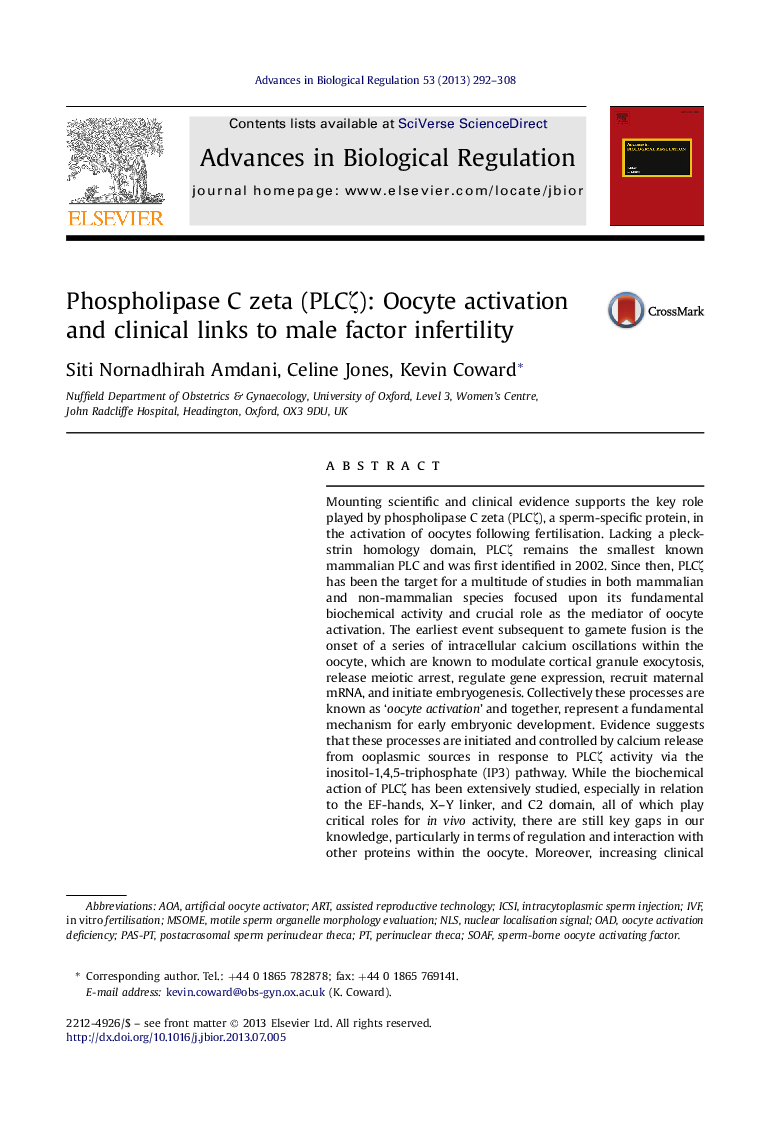| کد مقاله | کد نشریه | سال انتشار | مقاله انگلیسی | نسخه تمام متن |
|---|---|---|---|---|
| 1924526 | 1049103 | 2013 | 17 صفحه PDF | دانلود رایگان |

Mounting scientific and clinical evidence supports the key role played by phospholipase C zeta (PLCζ), a sperm-specific protein, in the activation of oocytes following fertilisation. Lacking a pleckstrin homology domain, PLCζ remains the smallest known mammalian PLC and was first identified in 2002. Since then, PLCζ has been the target for a multitude of studies in both mammalian and non-mammalian species focused upon its fundamental biochemical activity and crucial role as the mediator of oocyte activation. The earliest event subsequent to gamete fusion is the onset of a series of intracellular calcium oscillations within the oocyte, which are known to modulate cortical granule exocytosis, release meiotic arrest, regulate gene expression, recruit maternal mRNA, and initiate embryogenesis. Collectively these processes are known as ‘oocyte activation’ and together, represent a fundamental mechanism for early embryonic development. Evidence suggests that these processes are initiated and controlled by calcium release from ooplasmic sources in response to PLCζ activity via the inositol-1,4,5-triphosphate (IP3) pathway. While the biochemical action of PLCζ has been extensively studied, especially in relation to the EF-hands, X–Y linker, and C2 domain, all of which play critical roles for in vivo activity, there are still key gaps in our knowledge, particularly in terms of regulation and interaction with other proteins within the oocyte. Moreover, increasing clinical evidence has revealed a strong correlation between certain types of male infertility and the aberrant expression, localisation, structure and function of PLCζ in human sperm, particularly in cases of recurrent intracytoplasmic sperm injection (ICSI) failure, globozoospermia, and oocyte activation deficiency (OAD). In addition, two heterozygous substitution mutations have been identified in the coding sequence of PLCζ in one particular patient causing disruption to the catalytic X and Y domains and resulting in infertility. Although, such cases can be treated via the use of artificial oocyte activators (AOAs) such as calcium ionophores, significant concern remains over the use of such chemical agents, largely due to the fact that calcium release manifests as a single transient, rather than a series of oscillations as observed during normal fertilisation. Current interest in PLCζ is thus to develop a series of prognostic, diagnostic and therapeutic approaches which could first identify male patients that are deficient in PLCζ and then rescue oocyte activation ability via assisted reproductive technology (ART) and a pure, functionally-active, recombinant human PLCζ protein. While significant progress has been made in such areas over recent years, there is a clear need to translate scientific findings to clinical settings in order to maximise successful outcome for patients.
Journal: Advances in Biological Regulation - Volume 53, Issue 3, September 2013, Pages 292–308